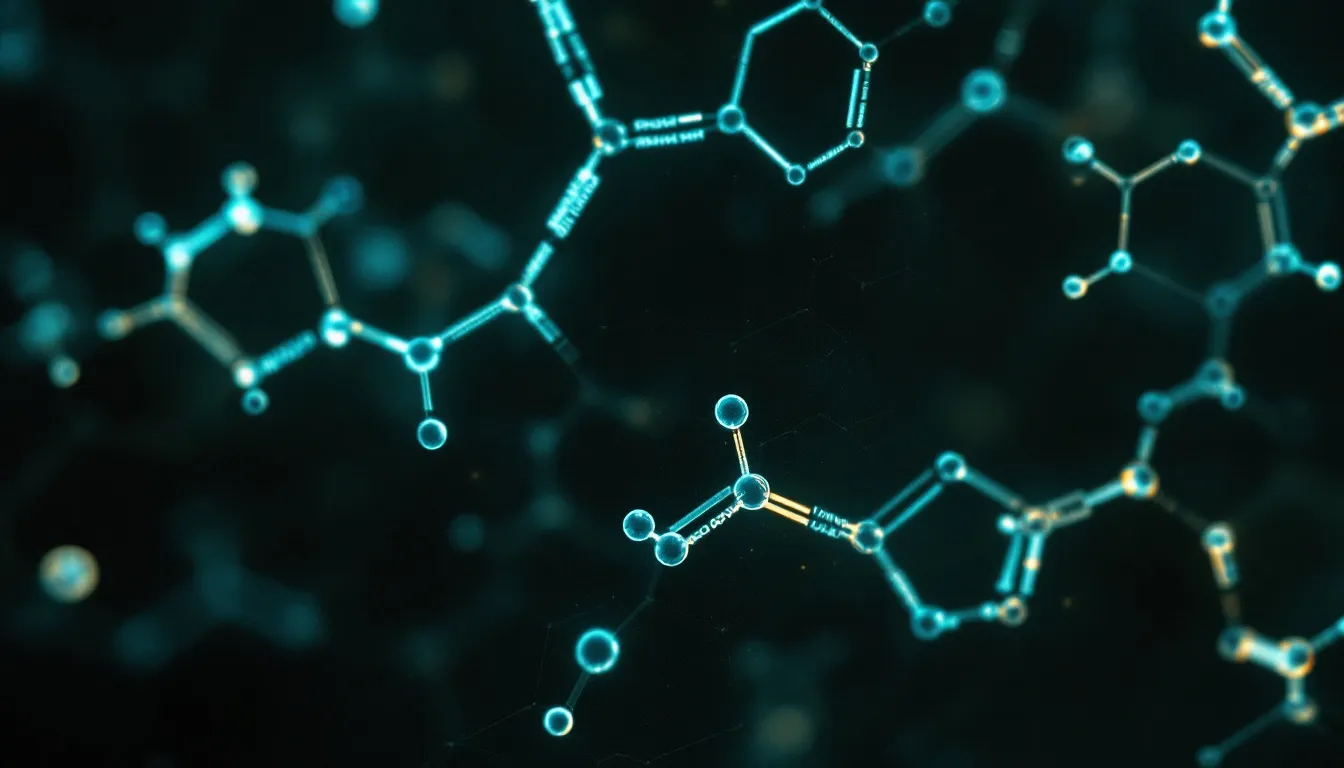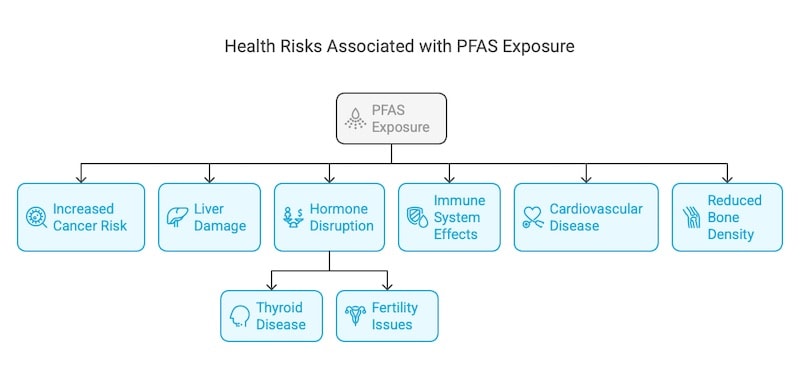Table of Contents
PFAS in Clothing: How to Protect Yourself from These “Forever Chemicals”
This page may contain affiliate links. We may earn a commission on purchases, at no additional cost to you. Learn more →
Are you worried about PFAS in clothing and other the chemicals touching your skin every day? You might be surprised to learn that your favorite rain jacket, those stain-resistant school uniforms, or even your go-to yoga pants could be harboring potentially harmful "forever chemicals" called PFAS. These synthetic compounds don't break down in the environment, linger in soil and groundwater, contributing to global pfas contamination and can build up in your body over time, potentially contributing to serious health issues. And the scariest part? Most clothing labels won't tell you they're there.
Per- and polyfluoroalkyl substances (commonly called PFAS chemicals) are used in numerous consumer products, from food packaging to makeup. In the textile industry, manufacturers often rely on PFAS for repelling water and adding stain resistance to clothes. Understanding the risks of PFAS exposure, along with new regulations banning PFAS in various textiles, can empower you to make better choices about what you wear—especially on little ones.
In this comprehensive guide, I'll walk you through what PFAS are, why they're in your clothes, their potential health effects, and—most importantly—how you can make smarter choices to protect yourself and your family.

Key Takeaways
-
PFAS are "forever chemicals" used in clothing since the 1940s to make fabrics water-resistant, stain-resistant, and oil-resistant. They're called "forever chemicals" because they don't break down, potentially lasting for centuries and accumulate in your body.
-
PFAS in clothing is widespread, particularly those marketed as waterproof, stain-resistant, or wrinkle-free. Studies have found PFAS in 64% of tested jackets, shirts, and swimsuits, and school uniforms. Performance gear like Gore Tex often include side chain fluorinated polymers containing PFAS.
-
Health risks from PFAS exposure include potential links to certain cancers, hormone disruption, immune system suppression, high cholesterol, fertility issues, and developmental delays in children.
-
PFAS don't stay in your clothes forever – they wash out during laundering and leach from discarded textiles, polluting waterways and landfills where they can eventually migrate into soil and drinking water sources.
-
Bans and Regulations Are on the Rise: Several U.S. States like New York and California have banned PFAS in intentionally added textile finishes, with more expected to follow. The European Chemicals Agency is considering a universal restriction on PFAS in consumer markets (ECHA).
-
PFAS Free Alternatives Exist: Many manufacturers are eliminating PFAS from outdoor clothing and everyday apparel by using silicone-based, polyurethane, or other safer coatings. Look for “PFAS-free” labels, natural fibers, and other signals that products contain less PFAS.
What Are PFAS and Why Are They in Your Clothes?
PFAS are a large group of human-made chemicals used in industry and consumer products since the 1940s. Per and Perfluoroalkyl substances are synthetic compounds known for their unmatched ability to resist water, oil, and heat.
These chemicals quickly found their way into countless consumer products, including non-stick pans, waterproof coatings, certain personal protective equipment, and, yes, textile products such as performance clothing.
Their seemingly magical properties—like repelling water—make them handy in everyday life but challenging to break down in wastewater treatment plants.
According to the Agency for Toxic Substances and Disease Registry, PFAS encompass thousands of variants. Their core characteristic—the carbon-fluorine bond—is among the strongest bonds in organic chemistry, earning them the nickname “forever chemicals.” They all share one troubling trait: they break down extremely slowly in the environment and can accumulate over time in living organisms (EPA, 2022). This persistence is why they've earned the nickname "forever chemicals."
When you purchase a raincoat that keeps you dry in a downpour, or pants that resist coffee spills, there's a good chance PFAS are involved. A PFAS-based finish can make fabrics waterproof or water-repellent, causing rain to bead up and roll off your jacket instead of soaking through (The Guardian, 2023). The same treatments help school uniforms resist stains and athletic wear wick away sweat and odors.

PFAS in Clothing—Where, Why, and How?
Not all clothing contains PFAS, but these chemicals are widespread, especially in performance and specialty apparel. The presence is especially common in items labeled "water-resistant" or "stain-proof." Tellingly, a study found that items without those marketing claims generally had no detectable PFAS. This indicates that PFAS use in clothing is usually intentional – manufacturers deliberately apply PFAS coatings to achieve specific performance benefits.
Some specific examples of PFAS-laden apparel include:
-
Raincoats and outdoor gear: Durable Water Repellent (DWR) coatings on rain jackets, ski wear, hats, and boots often use PFAS to keep water out (National Geographic, 2022). Many "all-weather" or "extreme weather" garments have historically relied on PFAS-based finishes for performance.
-
Activewear and athleisure: PFAS-based "side-chain fluorinated polymers" are used on sports bras, leggings, yoga pants, and athletic tops to wick away sweat and oil. A 2022 investigation found PFAS markers in 25% of tested workout leggings and yoga pants, including from major brands like Lululemon, Athleta, and Old Navy
-
School uniforms and work uniforms: Stain-resistant uniforms can contain surprisingly high PFAS levels. A peer-reviewed study published in 2022 found that all tested school uniform pants and shirts (from nine different brands) had PFAS finishes, even those advertised as 100% cotton. The researchers measured notable concentrations of PFAS, raising concern since children may wear these uniforms for 8+ hours a day.
-
Footwear and accessories: PFAS are also used in some shoes, hats, gloves, and bags – anything where water-repellency is a selling point. Water-resistant hiking boots or stain-proof ties are often treated with PFAS.
-
Household fabrics: Beyond clothes, PFAS treatments are common in textiles like upholstery, outdoor furniture fabric, curtains, and even bedding. One report in 2022 found PFAS in waterproof mattress pads and bedding as well (EWG, 2022).
In summary, PFAS have been integrated into clothing and textiles to make our lives more convenient – keeping us dry, stain-free, and comfortable. But as we'll explore next, these chemical conveniences come at a potential cost to both our health and the environment.
Health Risks of PFAS in Clothing
Although drinking contaminated water or eating PFAS-laden foods is generally considered the largest pathway, wearing PFAS-treated clothes still adds to your overall exposure. When you wear clothing containing PFAS, you're not likely to experience immediate health problems – there's typically no rash or acute reaction. The concern is more subtle and long-term: PFAS can migrate out of products and accumulate in your body over time, contributing to a cumulative toxic burden.
A growing body of scientific research suggests that PFAS exposure is linked to a range of chronic health problems. According to the Agency for Toxic Substances and Disease Registry (ATSDR) and recent National Academies reports, some of the health risks associated with PFAS include:
-
Certain cancers: Increased risk of kidney, testicular, prostate, and possibly other cancers has been linked to PFAS exposure in studies. The National Academies of Sciences (2022) concluded there is sufficient evidence connecting PFAS with elevated cancer rates (National Academies, 2022).
-
Hormone disruption: PFAS can interfere with your endocrine system. Observational studies have found associations with thyroid hormone imbalances, and PFAS are suspected of affecting other hormones that regulate metabolism and reproduction.
-
Immune system effects: PFAS exposure correlates with a reduced immune response and higher susceptibility to infections. In fact, weakened immune function (including in children) is one of the most consistently observed PFAS effects.
-
High cholesterol and metabolic issues: Elevated blood cholesterol levels have been linked to PFAS in multiple studies. Some PFAS may also contribute to weight gain or obesity risk, though research is ongoing.
-
Reproductive and developmental harms: PFAS have been associated with fertility problems, pregnancy-induced hypertension (pre-eclampsia), and low birth weight in infants. They may also delay childhood development (e.g., puberty timing or learning impacts).

PFAS Exposure from Clothing vs. Other Sources
It's important to note that most PFAS health studies involve ingestion (drinking water) or occupational exposure, not clothing specifically. The science on how much PFAS is absorbed through the skin from apparel is still developing.
Dr. Stuart Harrad, an environmental chemist studying this pathway, notes that PFAS in clothing "is certainly something that we shouldn't be ignoring," even if skin absorption is slower than ingestion (The Guardian, 2023).
However, dermal exposure (skin contact) is likely a less efficient route for PFAS to enter the bloodstream compared to swallowing or inhaling PFAS. Dr. Ned Calonge of the Colorado School of Public Health explains that it's generally harder for these chemicals to penetrate intact skin than to be absorbed through the gut (CBS News, 2023).
In plain terms, the PFAS in your jacket probably deliver a lower dose than the PFAS in a sip of contaminated water. That's why drinking water and food are bigger contributors to PFAS exposure than clothing.
Nevertheless, any exposure adds to your overall "forever chemical" load – and given the potential health effects, minimizing all avoidable PFAS sources is wise.
Children may be at higher risk from PFAS, since their bodies are still developing and they often have more exposure relative to body weight (kids play on floors, put things in their mouths, etc.). The fact that children's uniforms and pajamas have been found with PFAS is especially concerning.
In summary, wearing PFAS-treated clothing won't make you sick overnight, but it could contribute in small ways to health issues over the long term. Many of the health risks of PFAS (cancer, immune effects) are chronic conditions that develop after years of cumulative exposure. This is why it is important to eliminate unnecessary PFAS exposures wherever possible – including those from our wardrobes.

The Push to Ban PFAS—What’s Happening Now?
In light of mounting evidence about PFAS risks, governments are moving to restrict or ban PFAS in consumer products, including textiles. While there isn't a comprehensive U.S. federal ban on PFAS in clothing yet, state-level legislation and proposed national rules are rapidly changing the landscape.
United States State-Level Bans
In the U.S., PFAS are not yet fully banned at the federal level. However, states like New York and California have passed laws to phase out or ban PFAS in intentionally added clothing finishes, with compliance deadlines around 2025 (NY Senate). Washington State, Maine, and Colorado are among other jurisdictions restricting PFAS in outdoor gear, carpets, and other textile products.
For example, Colorado’s legislation requires labeling PFAS in certain textiles and aims for a ban on items with pfas content in the near future. Many companies face pressure to adapt their supply chains quickly to comply or risk losing access to huge markets.
On the federal level in the U.S., regulators have focused primarily on PFAS in environmental media (water, soil) rather than consumer goods. However, there are notable developments:
-
The EPA (Environmental Protection Agency) finalized a new rule in 2023 to prevent unauthorized new PFAS from entering commerce. This rule is essentially a "significant new use rule" (SNUR) that requires any company attempting to use 329 older PFAS chemicals (that were phased out) to get EPA approval first . While not directly a clothing ban, it blocks industry from resurrecting discontinued PFAS without oversight.
-
The EPA has also begun the process of designating certain PFAS (PFOA, PFOS) as hazardous substances under federal law (CERCLA), which indirectly pressures companies to avoid using PFAS in products to limit liability.
-
In Congress, the proposed PFAS Action Act (which passed the House in 2021 but not the Senate) included provisions to establish a "PFAS-free" labeling standard for consumer products. If such legislation passes in the future, we could see clothing items carry a "PFAS-Free" mark similar to organic or non-GMO labels, making it easier for shoppers to choose safe products.
International Developments
Actions abroad will also affect the U.S. market:
-
Across the Atlantic, the European Chemicals Agency is examining a comprehensive ban—often called a universal restriction—on all PFAS in consumer products, including clothing and outdoor equipment (ECHA). If enacted, this legislation would transform how global manufacturers create fabric finishes. Since the EU is a massive market, international brands are unlikely to maintain separate PFAS and PFAS-free lines. Instead, they might move to pfas free coatings worldwide.
-
Canada and others: Canada is working on PFAS restrictions aligned with the US and EU efforts. In 2023, Canadian authorities signaled intent to curb PFAS in consumer products (they already ban certain PFAS in cosmetics). Other countries like Australia and Japan are monitoring and may follow suit as global consensus builds.
The bottom line on regulations: Laws are finally catching up with PFAS in clothing, and the direction is clear – phase them out. For now, regulations are patchy (varying by jurisdiction), but they send a strong message to manufacturers.
How to Avoid PFAS in Clothing and Protect Yourself
What can you do as a consumer concerned about PFAS in your wardrobe? Here are practical steps and tips, drawn from expert advice and emerging best practices:
Check Labels and Certifications
One of the easiest ways for You to avoid PFAS is to check product labels thoroughly. Terms like “water resistant” or “stain resistant” often signal possible use of PFAS, unless a brand explicitly states “pfas free” or “non-fluorinated.” Certain certifications, such as GOTS, bluesign® or OEKO-TEX®, sometimes verify that less harmful chemicals are used, although not all certification systems cover PFAS fully.
Major Certifications Addressing PFAS
|
Certification |
Scope & Coverage |
Approach to “Forever Chemicals” (PFAS) |
|---|---|---|
|
bluesign® |
Focuses on the entire textile supply chain, from raw materials to final product. Ensures responsible and safe use of chemicals, energy, and resources. |
Prohibits a range of hazardous substances, including certain PFAS. bluesign® regularly updates its chemical blacklist to align with emerging data on the toxicity and persistence of these “forever chemicals,” aiming to phase them out wherever possible. |
|
OEKO-TEX® STANDARD 100 |
Tests for harmful substances in textiles and accessories at different processing stages. Certification applies to raw fibers, yarns, and final garments. |
Restricts or bans specific PFAS (like PFOA and PFOS), setting limit values based on health and environmental considerations. While not all PFAS are entirely eliminated, OEKO-TEX® keeps tightening requirements to reduce potential PFAS exposure from certified products. |
|
GOTS (Global Organic Textile Standard) |
Focuses primarily on organic fibers (e.g., cotton, wool). Requires certified products to meet strict ecological and social criteria at all stages of production. |
Prohibits the use of toxic finishing treatments, which covers most intentionally added PFAS. Under GOTS, any chemical inputs must conform to environmental and toxicological safety requirements, effectively barring PFAS-based coatings that are designed to repel water or stains. |
Opt for Natural, Untreated Fabrics
When possible, choose materials that don't require PFAS to perform. For everyday wear, 100% cotton, wool, bamboo, hemp, or silk can often meet your needs without added chemicals. These natural fibers are less likely to have been coated with PFAS (with the exception of some specialty wool outdoor gear).
Synthetic fabrics (polyester, nylon, spandex) are more commonly the ones that get performance finishes like DWR. Natural fabrics have their own environmental considerations, but from a chemical standpoint, a plain organic cotton shirt is a safer bet than a polyester shirt claiming to be "stain-proof."
Use and Wash Clothing Wisely
If you already own PFAS-treated clothing (like that favorite rain jacket or yoga pants), you don't necessarily need to toss them immediately. Consider how you use them. Wearing a PFAS-coated raincoat over layers (so it's not directly on your skin) can reduce any dermal exposure. And, as counter-intuitive as it sounds, it may be more environmentally responsible to continue using it as long as possible rather than discarding it.
When it comes to laundering, studies note that washing can significantly reduce PFAS levels in clothing. A warm wash with detergent might remove some of the surface chemicals. The trade-off is those PFAS go into the wastewater.
Keep in mind washing won't remove all PFAS – some are bonded at a molecular level to fibers – but it can cut down residual finishes. Always wash such items separately to avoid spreading any PFAS to other clothes via wash water or dryer exhaust.
Dispose Responsibly: Donating or recycling is good practice, but be aware that pfas pollution can still occur if these items end up in the wrong facility. Look for specialized take-back programs, if available.
Reduce Overall PFAS Exposure
Beyond clothing, remember that PFAS are in many products. To protect your health, you can take broader actions like using a home water filter (activated carbon or reverse osmosis
Beyond clothing, remember that PFAS are found in many everyday items. To protect your health, you can take broader actions like using a home water filter—either activated carbon or reverse osmosis—to reduce PFAS in your drinking water. Additional strategies include avoiding nonstick cookware coated with PFAS-based finishes, checking personal care product labels for hidden fluorinated ingredients, and minimizing exposure to fast-food packaging known to contain grease-resistant coatings.
FAQ to PFAS in clothing
Can You absorb PFAS from clothes?
Yes. While drinking water and food packaging often deliver a higher dose, clothing can still contribute to potential exposure. According to the Agency for Toxic Substances and Disease Registry, PFAS can migrate from treated fabric to skin over time, although ingestion remains the largest overall concern.
How do I know if my clothing has PFAS?
Look for buzzwords like “water resistant,” “stain resistant,” or “fluoro” in the product label or care instructions. Check brand websites for “PFAS free” claims. If a garment claims “side chain fluorinated polymers,” it’s a strong sign PFAS are used.
What fabric has no PFAS?
Many natural fibers, such as organic cotton, hemp, wool, or linen, typically have less PFAS because they do not require heavy chemical coatings for performance. Looki for minimal finishes and verifying if a brand states “pfas free alternatives.”













